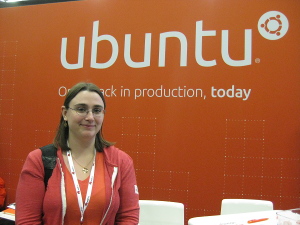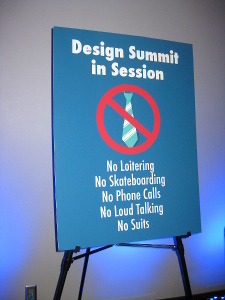Since my new job is working with the OpenStack infrastructure team, I am able to attend the OpenStack Design Summit this week in Portland, Oregon!
I woke up just before 4AM on Monday to take a 6:15AM flight to Portland, putting me in Portland shortly after 8AM and to the conference center around 9AM, at the start of the event. I learned quickly that the unfortunate part about arriving at that time is the huge registration lines:
ODS is very similar to the UDS (Ubuntu Developer Summit) that used to be held twice a year by Canonical, indeed it was somewhat modeled after it. It’s nice to have the UDS experience under my belt so everything felt familiar and I was able to dive into sessions without feeling lost. It’s also been delightful to run into a lot of people who I know from the Ubuntu community who are also now working on OpenStack in some capacity.
There are a few differences though. First is the attendees, while UDS really was all about people developing the pieces of Ubuntu (software, packaging, documentation, design), ODS is a summit for both developers and users. Then there is the size of the summit. I don’t believe UDS ever broke 1000, but the expanded scope of ODS means that there are a lot more people, I believe the number floating around is somewhere around 2500. The format is also slightly different, instead of every session being workshop-like where you all sit around working on a blueprint for something, there are also presentations. The topics for presentations do range a bit, many being user-focused but also developer-focused ones to entice development and feedback on new initiatives. It has made for a really interesting mix that I’m quite enjoying.
The first two sessions I attended were OpenStack-on-OpenStack Overview (or “TripleO”), which was a workshop session going through some of the general ideas and blueprints for TripleO plans this cycle and sessions at the summit. I was then off to Robert Collins’ standing-room-only presentation of OpenStack on OpenStack: deploying OpenStack via bare-metal.
Now I am quite familiar with the TripleO project, having worked on testing baremetal stuff in their incubator these past several weeks to work out how we’ll be eventually including it in the OpenStack continuous integration testing infrastructure. It was however nice to take a step back and look at the more broadly with the more long-term view.
In the afternoon I attended a couple documentation-related sessions, starting off with Translation management enhancement. The project has translations for documentation that have been chugging along, but it seems like these past several months and into this next cycle they’ll be working to expand upon this and make it more organized and streamlined for contributors. Then there was a session for Documentation for Newly Integrated Projects, where questions around when to integrate were raised (while they are in incubator? after? upon release where they are official?). I was happy to learn from this session that the docs in general were going through a bit of a reorganization that had been discussed early in the day, while I have found the existing ones to be an invaluable resource and am delighted that OpenStack has placed such a commitment on docs from an early point, there is always room for improvement and making things easier for everyone!
Toward the end of the day I got to my first testing-related session (which, strictly-speaking is most applicable to my job as someone on the team who runs the infrastructure for the CI-related testing), Reviewing OpenStack Networking Unit Tests. In this session they reviewed the current tests they are doing with OpenStack Networking, looking over types of tests, their effectiveness and current speed at which they run.
I also made it down to the expo hall. It was full of OpenStack!
It was pretty cool to see all these companies so invested in the project already.
And thanks to Benjamin Kerensa for taking my photo at the Ubuntu booth:
Monday evening I went out with a bunch of my colleagues to Montage for some fun conversation and delicious Louisiana-inspired food (I had spicy, cheesy macaroni with alligator).
Tuesday was a busy day. The opening of the day was an exciting one, Jonathan Bryce, Executive Director of the OpenStack Foundation, gave a talk where he discussed the progress of OpenStack and then introduced three major companies who are all using it in some capacity: Bloomberg, Best Buy and Comcast. It’s always super motivating to see major companies like these making this kind of serious investment in a technology you’re working on.
As far as sessions go, I started off by going to the Heat RefStack – A reference implementation of OpenStack talk by Monty Taylor of HP and Rob Hirschfeld of Dell (amusingly the computer they presented from was a Thinkpad). The core of their talk was really focused around interoperability between the public clouds running OpenStack so customers truly have options when it comes to selecting providers. To meet this they introduced RefStack, a plan for an OpenStack reference implementation.
I was then in testing mode for pretty much the rest of the day! Started off with Strategies for Gating in a growing project as discussions centered around how to best handle the number of tests increasing as more projects are added and existing ones get larger. After lunch it was in to Multi-node Openstack Testing, which began with an Openstack in Openstack (not to be confused with on) presentation by a group who has been working on their own OpenStack running on Openstack implementation for testing and more. Then it was on to discussing how the CI team may be using TripleO style testing for the baremetal testing, and since I’ve been working on this it was a chance for me to take a more active role in participating in a session. I even sat up front. From there it was on to FITS testing of public clouds, where some of the mechanisms and ideas for a testing mechanism for OpenStack deployments could be tested for inclusion of certain features, perhaps even implementing an eventual “certification” type program that tracks public clouds that are using enough OpenStack to be considered OpenStack-powered clouds.
Gating/Validation of OpenStack Deployments was next up. The QA team has many types of tests that they do, and there was some discussion about what should go into the CI infrastructure vs. what should be tested by developers and beyond, not necessarily being things that code commits depend upon. A fair amount of talk was around things like stress testing, which can be sometimes difficult to do in a virtual environment where results depend upon the cloud it was running on, but more on that in a moment. I then attended Upgrade testing and Grenade, Grenade is a tool which, using devstack, tests an upgrade from one OpenStack release to another and was deployed on the CI infrastructure this past cycle so this discussion was to discuss changes and improvements. Last session of the day was Beyond the API – End to End Testing of OpenStack, which is where the topic of resource performance testing came up again. The was consensus that while it’s tricky to do on hosted cloud VMs due to variability of environment, these more qualitative tests could be tracked based on averaging out tests through metrics that the CI team already produces (or could work toward producing more/better of). This way they don’t need specific details about how each individual test runs for some of this, but instead could rely upon over time metrics to show if there are any kinds of trends.
Tonight! Each night there are parties put on by sponsors, and tonight was the one by HP. Of all the conference parties I’ve been to, I have to say this was one of my favorites. They had people going around serving drinks and food, the food selection was enjoyable to me, the venue was spacious and it wasn’t too noisy – you could easily have conversations! And conversations I did have, mostly with the awesome Portland Debian folks who came by and various Ubuntu folks who I know through my Ubuntu work.
It was a great start to the week, looking forward to the next two days!






